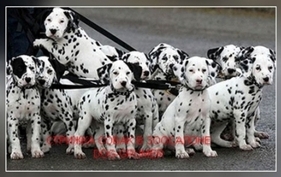 |
Dalmation
Other Names: Dal Country of origin: Former Yugoslavia, possibly India/Balkans Dog Group Kennel Club : Utility General appearance: One of the most noteable things about a Dalmation is its spotty appearance. Apart from this, Colours: A white base with spots that are usually black but brown variations are found. Size: Bitch 56cm - 58cm Weight: Min Max Bitch 23kg (51lbs) 25kg (55lbs) Temperament: Dalmations are friendly dogs but they do need plenty of exercise due to the fact that they were originally bred as coach dogs. They are energetic and playful and said to be good with children, horses and humans. Dalmations are dedicated and loyal and always want to please but because of their determined natures will easily form bad habits. They are mild-mannered, affectionate dogs who enjoy company and clowning about. However, their strength and stamina can sometimes be too much of a challenge for some owners. They can take at least 2 years to settle down. They are extremely sensitive and do not do well if left alone for extended periods of time. If they become lonely or bored they will become depressed and destructive. Movement: Free with a long stride. Care and training: The Dalmatian requires frequent brushing with a firm bristle brush to minimize loose hair. This breed requires intensive and extensive early and lifelong socialization as well as basic obedience. Without training, the Dalmatian has a propensity to be timid or high-strung. Training must be done with firmness, fairness, consistency, reward, and patience. Excessive praise when they have done well is important. It is, however, as easy for them to learn bad habits as well as good so do remember their determination, and, especially the dominant nature of male dogs. Overall Exercise: 2 hours per day Dals are a breed of incredible endurance and are able to travel at a moderate pace almost indefinitely. Owners should remember this when it comes to exercise and ensure that they are given sufficient running time and roadwork to build up and maintain the muscled outline. Feeding requirements: Dalmatians are not fussy eaters
Exercise: High Grooming: Low Noise: Low Personal Protection: Medium Suitability As Guard Dog: High Level of Aggression: Low Compatibility With Other Animals: High Suitablity for Children: High Often docked: No Average litter size: 8-10 Life expectancy (yrs): 12 - 14 Health issues: Due to their pure white color at birth, they are prone to inherited deafness. This breed is the only breed susceptible to urinary stones. Other health concerns include skin allergies, epilepsy . History: The name is taken from Dalmatia, a coastal region on the Adriatic Sea north of Albania. The breed is listed in the FCI as part of the former Yugoslavia due to early records of the breed's existence there. Records of Greek hunting dogs from over 4000 years ago indicate they used the Dalmatian. There is also convincing evidence to suggest that the Dalmatian came from India. Regardless of where the Dalmatian sprang from, its popularity took rise in Great Britain. It was here that the Dalmatians became well established as a dog of the British aristocracy, running alongside their horse-drawn carriages. As well as pleasing to the eye for royalty, the dog truly had its start clearing the way through crowded areas for the carriages. They have been used as a watchdog, draft dog, shepherd, ratter, bird dog, trail hound, retriever, circus and stage performer and of course as a firehouse mascot. The breed had its start with firehouses when horse-drawn fire carriages used Dalmatians to clear the way ahead, much like the siren of an ambulance. Due to the invention of automobiles, the breed's popularity and use declined. Despite the decline, their registration doubled following the 1959 film "101 Dalmatians", making the breed even more popular. In 1978 a final boost to the breed's popularity was in thanks to Mrs. E. J. Woodyatt, who's Dalmatian won the Best in Show award at the Crufts Dog Show in England.
|
|
|
|
